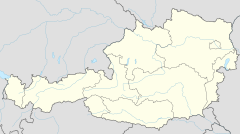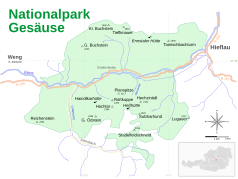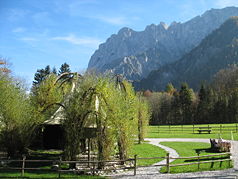Gesäuse National Park
| Gesäuse National Park | ||
|---|---|---|
| Cataract stretch of the Enns | ||
|
|
||
| Location: | Styria , Austria | |
| Surface: | 12,118 ha | |
| Founding: | October 26, 2002 | |
| Address: | Nationalpark Gesäuse GmbH Weng 2 A-8913 Weng im Gesäuse www.nationalpark.co.at |
|
| Overview map of the national park | ||
| Willow Dome | ||
| Hochtor, in the mountain area of the national park | ||
The Gesäuse National Park was founded in 2002 and extends in the Austrian state of Styria over the villages of Admont , Johnsbach , Weng , Hieflau , Landl and St. Gallen . These localities are administered in the large municipalities of Admont, Landl and St. Gallen.
geography
The currently (according to GIS) 12,118 hectares (around 120 km²) area is located west of the Enns knee in Upper Styria . The planning area at the time of its establishment comprised a total of 125 km². Over 99% of the current area is owned by the Styrian State Forests, only a small percentage is public or private. Characteristic are the steep Gesäuse mountains with their striking cliffs and the gorge-like valley stretch of the Enns between the Gesäuse entrance and Hieflau . The altitude is between 490 m to 2369 m ( Hochtor ).
Zoning
The national park is divided into a nature zone and a conservation zone . The natural zone covers around 75% of the area and will remain free of interference after the planned management measures have been completed. The conservation zone allows restricted forms of use (such as extensive alpine pasture farming ) and includes infrastructure.
In order to get closer to the goal of freedom from interference, after extensive preparations in 2018, 85% of the area was designated as biotope protection forest (according to §32a Forest Act 1975). In this case, the landowner is released from the obligation to take mandatory measures against bark beetle infestation. While no forest hygiene measures are carried out in this designated zone, such measures are strictly implemented in the remaining areas in order to protect adjacent forest operations and infrastructure from the effects of large-scale calamities.
Natural space
The habitats of water, forest, alpine pastures and rocks are the defining elements in the Gesäuse National Park. Due to their special importance, they were incorporated into the national park's logo in the form of blue, green and gray stripes. The river Enns thunders its way through a gorge at the natural monument Gesäuseeingang . Behind it it is fed by the Johnsbach and Hartelsgraben feeders, as well as numerous partly only temporary bodies of water. About half of the national park area is covered by forest. In the valley you can find alluvial forests and maple-ash forests. Snow heather pine forests grow as ice age relics in some locations. Spruce-fir-beech forests make up a large proportion of the area, although many forests were heavily influenced by forestry in the past and today the spruce dominates. The larch mixes in at higher altitudes. As a specialty, the easternmost stands of Swiss stone pine grow here . Above the tree line, the mountain pine forms a closed crooked wood belt. Due to the high relief energy, however, plants also migrate in the rubble and avalanche channels down the valley, so that a large number of alpine plants (and animals) can also be found near the valley in the Gesäuse National Park.
Specially protected species
Proven types of Habitats Directive are Apollo butterfly , thyme-Large Blues , Spanish flag , brown butterfly and Marsh Fritillary , Alpine longhorn beetle , yellow-bellied , Koppe , Ukrainian brook lamprey , Barbastelle , lesser horseshoe bat and otter . Among the plants, yellow lady's slipper , green fork tooth moss and green goblin moss are listed.
Of the 90 breeding bird species that occur, 17 species are listed in Annex I to the Birds Protection Directive and 24 are endangered across Austria.
Endemic
The Gesäuse National Park is a hot spot for endemics . The density of species with a small geographical distribution is particularly high in this part of the Northeastern Limestone Alps. The official website of the national park lists 15 endemic plant species, including the Styrian spring carnation , the north-eastern alpine poppy and the Austrian bellflower . Among the animal species, 89 endemic species are named, including the northern giant eye, a harvestman, and the Styrian dam runner, a ground beetle.
history
- At the end of the 19th century, the Styrian State Forests were founded to protect against soil speculation.
- In 1913 there were first proposals for the creation of a Styrian nature reserve in the Niedere Tauern and at the same time plans for the large-scale use of hydropower in the Gesäuse.
- In 1958, by ordinance of the Styrian state government, the Gesäuse and the subsequent Ennstal up to the state border and the Wildalpener Salzatal were declared to be the first nature reserves in the state.
- In 1977 a state parliament resolution for the creation of the Niedere Tauern National Park was issued . Various studies and controversial discussions followed.
- In the fall of 1997, the forerunner of the Gesäuse National Park Association , which campaigns for the National Park, was created.
- In 1998 a protection association for the Gesäuse National Park was founded , which opposed the establishment of a national park.
- In 2001 there were several referendums that did not end uniformly.
- On March 12, 2002 the National Park Act was passed in the state parliament.
- On March 1, 2003, the ordinances, the National Park Declaration and the National Park Plan came into force.
- On December 5, 2003, the Gesäuse National Park was internationally recognized as a Category II protected area by the IUCN .
- On February 9, 2006 the tourism association Alpenregion Nationalpark Gesäuse was founded and expanded in November 2007. It comprised 12 municipalities until the end of 2014, then 5.
Tourism infrastructure
Gesäuse tourism association
| Alpine region Gesäuse National Park | |
|---|---|
| legal form | Community association |
| purpose | Regional interest group |
| Seat | Admont , Hauptstrasse 35 |
| founding | 2006 (new 2015)
|
| executive Director | David Osebik |
| Members | 5 municipalities |
| Organization type | Tourism association |
| Website | www.gesaeuse.at |
The three national park communities cooperate with other communities in the region in the Gesäuse Tourism Association . In the course of the structural reform of the municipality in Styria , the tourism association founded in 2006 was restructured in accordance with the Styrian Tourism Act 1992 (Section 4, Paragraph 3).
The municipalities are (in brackets the local class ):
- Admont (B)
- Altenmarkt near St. Gallen (C)
- Ardning (C)
- Landl (B)
- St. Gallen (B)
Important places
- Seat of the tourism association is Admont , there is for visitors the information office .
- The national park administration is located in Weng .
- In the middle of the national park, in Gstatterboden , is the national park pavilion . In addition to the gastronomy, the building offers a fascinating view of the Hochtor group. The building made of wood, glass and concrete is kept in the national park colors.
- In John Bach on the Enns, one finds the willow dome , one created from living trees and Plan Weiden Churches complex, and in which you. a. Can make presentations and microscope observations. In its immediate vicinity is the "Walkable Ecological Footprint", a further attraction for nature and environmental education.
- The themed trails include the "Au Adventure Trail" through the Lettmayr Au, the "Wild John" from the Weidendom to Johnsbach, the Johnsbacher Copper Trail between the copper mine in the Radmer and Johnsbach and the Luchs Trail , which includes the protected areas Kalkalpen National Park and Gesäuse National Park and the Dürrenstein wilderness area .
Web links
- Homepage of the national park (nationalpark.co.at)
- Gesäuse National Park on steiermark.com
- World Database on Protected Areas - Gesäuse National Park (English)
Individual evidence
- ↑ Fact sheet on biotope protection forest. Retrieved November 5, 2018 . Fact sheets of the Gesäuse National Park
- ↑ Official website of the Gesäuse National Park. Retrieved September 3, 2014 .
- ^ A b Daniel Kreiner, Alexander Maringer (Red.): First decade. Research in the Gesäuse National Park (= publications of the Gesäuse National Park. 9). National Park Gesäuse GmbH, Weng im Gesäuse 2012, ISBN 978-3-901990-08-3 .
- ↑ Wolfgang Rabitsch, Franz Essl: Endemiten. Treasures from Austria's flora and fauna. Natural Science Association for Carinthia, Klagenfurt 2009, ISBN 978-3-85328-049-2 .
- ↑ Tourism associations (individual associations and multi-community associations until December 31, 2014): ( Memento of the original from June 12, 2015 in the Internet Archive ) Info: The archive link has been inserted automatically and has not yet been checked. Please check the original and archive link according to the instructions and then remove this notice. Table 50 multi-municipality TV (§ 4 Paragraph 3 - Associations) with 273 tourist municipalities. Status: October 2014 (xlsx, verwaltung.steiermark.at, accessed June 11, 2015).
- ↑ The Gesäuse in Styria, Austria on steiermark.com.
- ↑ Tourism associations (individual associations and multi-community associations from January 1, 2015): ( Memento of the original from June 12, 2015 in the Internet Archive ) Info: The archive link was inserted automatically and has not yet been checked. Please check the original and archive link according to the instructions and then remove this notice. Tables 36 multi-municipality TV (§ 4 Paragraph 3 - Associations) with 128 tourist municipalities. Status: January 1, 2015 (xlsx, verwaltung.steiermark.at, accessed June 11, 2015).




